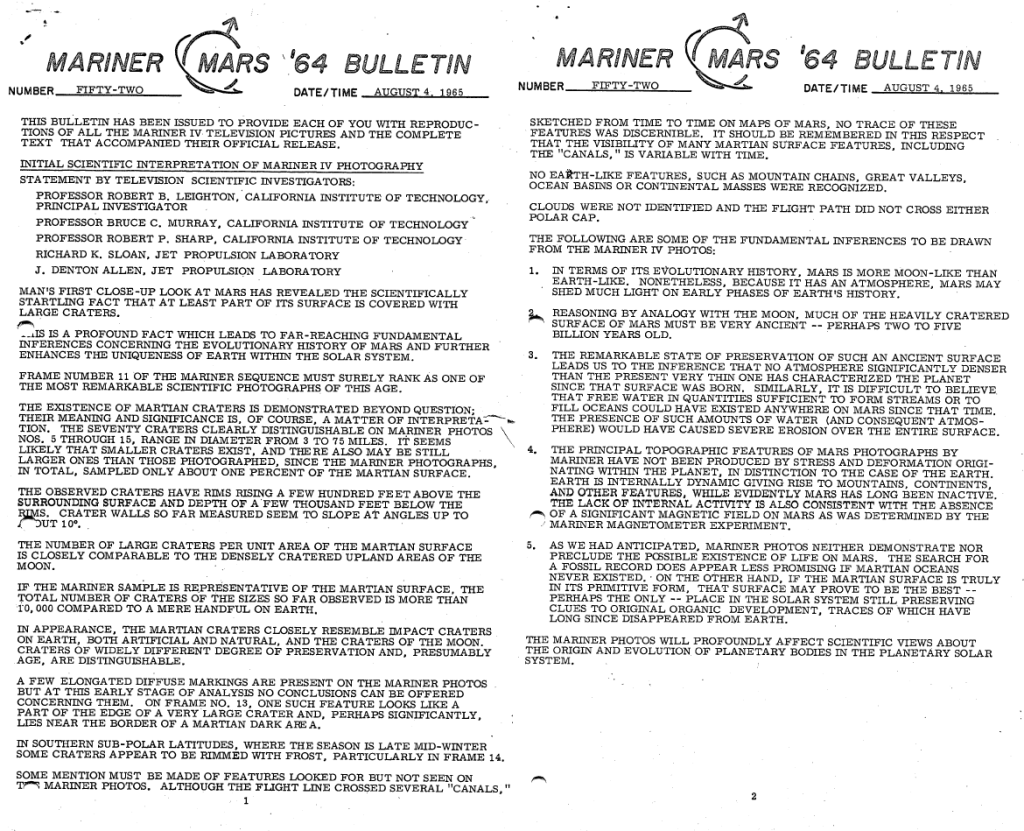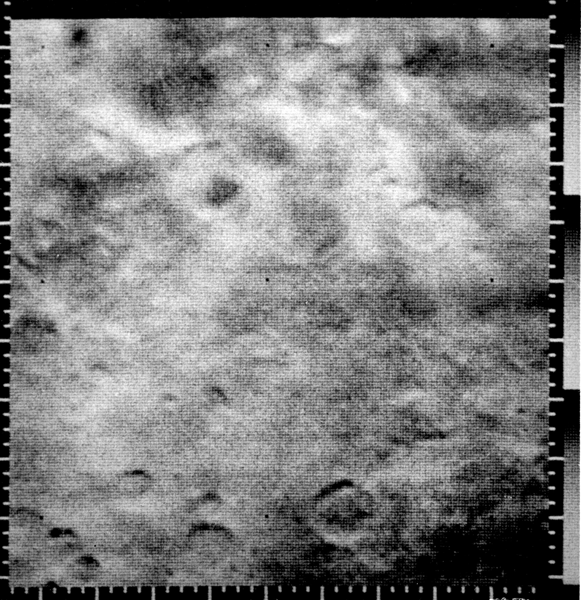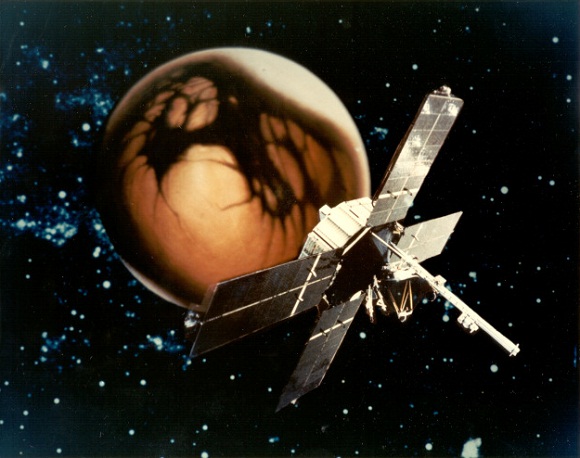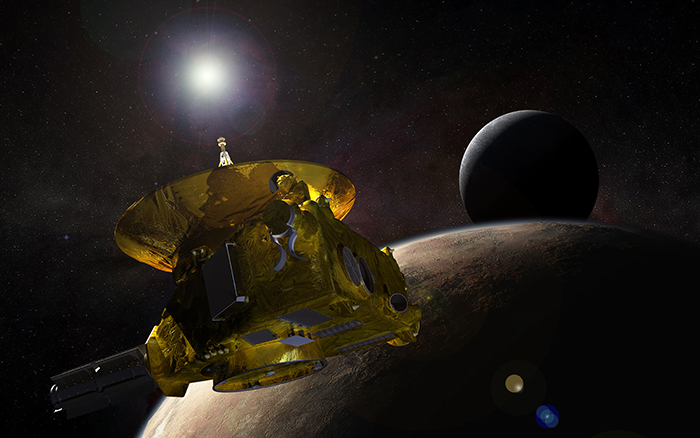At the 2013 annual meeting of the American Geophysical Union, Michael Carr give the Shoemaker Lecture on “Geologic Exploration Of The Planets: A Personal Retrospective Of The First 50 Years.” I was lucky to hear it, because he included this anecdote about Mariner 9’s arrival at Mars in 1971:
The planet was engulfed in a dust storm and very little could be discerned except for polar caps and some dark spots which turned out to be volcanoes poking up above the dust. As an aside, there was a lot of argument about those volcanoes. They looked exactly like calderas. But already by that time, the perception of Mars as a lunar-like body had solidified, and there was just enormous resistance to interpreting those dark spots as the summits of volcanoes.
Before Mariner 9 reached the red planet, Mariner 4 flew by on July 14, 1965, returning 22 images of a rugged, cratered surface that had never before been seen – not quite what the imaging team expected to find! This bulletin, circulated to the DSN stations along with the photos, sums up how these results affected the understanding of Mars and its planetary evolution:
Man’s first close-up look at Mars has revealed the scientifically startling fact that at least part of its surface is covered with large craters. This is a profound fact which leads to far-reaching fundamental inferences concerning the evolutionary history of Mars and further enhances the uniqueness of Earth within the solar system… Some mention must be made of features looked for but not seen on Mariner photos. Although the flight line crossed several “canals,” sketched from time to time on maps of Mars, no trace of these features was discernable. It should be remembered in this respect that the visibility of many Martian surface features, including the “canals,” is variable with time.
 Mariner 4 arrived at Mars to find it cold and barren – “more Moon-like than Earth-like” – and that revelation, as Mike Carr recalled, fueled the dominant perception of Mars for the missions that followed. The Mars of 1965 had to fit somewhere in our limited palette of planetary analogs, and the never-before-seen craters of the ancient highlands tipped the scale toward the lunar end. Ground-based observations of the seasonal cycle on Mars, evidenced by the retreat and expansion of polar caps and changes observed in shade and placement of darker regions, had inspired hopes of a geologically active planet, but the cratered terrains and absence of a magnetic field said otherwise. In fact, they said it so loudly that when Mariner 9 caught a glimpse of Olympus Mons “poking up above the dust,” it took a lot of convincing to entertain the notion that Mars might be more Earth-like than our first encounter suggested.
Mariner 4 arrived at Mars to find it cold and barren – “more Moon-like than Earth-like” – and that revelation, as Mike Carr recalled, fueled the dominant perception of Mars for the missions that followed. The Mars of 1965 had to fit somewhere in our limited palette of planetary analogs, and the never-before-seen craters of the ancient highlands tipped the scale toward the lunar end. Ground-based observations of the seasonal cycle on Mars, evidenced by the retreat and expansion of polar caps and changes observed in shade and placement of darker regions, had inspired hopes of a geologically active planet, but the cratered terrains and absence of a magnetic field said otherwise. In fact, they said it so loudly that when Mariner 9 caught a glimpse of Olympus Mons “poking up above the dust,” it took a lot of convincing to entertain the notion that Mars might be more Earth-like than our first encounter suggested.
Yesterday – fifty years to the day after Mariner 4’s Martian flyby – NASA’s New Horizons spacecraft made its closest approach to Pluto, and we have been bathed in ever more detailed images of the dwarf planet and its moons for the past several days. As the photos have gotten clearer, a chorus of comparisons has risen:
Pluto is red! It looks like Mars!
“Pluto looks remarkably like Mars–but a lot better than Mars, of course.” — Fran Bagenal, #PlutoFlyby #RedPluto pic.twitter.com/ff0GGva9Jk
— Corey S. Powell (@coreyspowell) July 14, 2015
Of course, Pluto isn’t red for the same reasons that Mars is red (space-weathered hydrocarbon molecules vs. iron oxides), so there are plenty of holes to poke in the analogy…
John Spencer: “This part looks like Mars, if you ignore the temperature and the composition and everything else.” — Emily Lakdawalla (@elakdawalla) July 14, 2015
It’s been very exciting to see Pluto come into focus, and even more interesting to watch the process of viewing, describing, and naming features that have gone from light or dark patches to “the whale” or “the heart.” I can’t avoid thinking of this process in the context of previous planetary quests, especially Mars exploration with its history of telescopic observation, flybys, orbiters, and rovers. It’s satisfying to see that Mars has graduated to become an analog for even newer worlds – what an exciting time to be alive!





[…] True Anomalies: Pluto, Mars, Moon, Earth […]